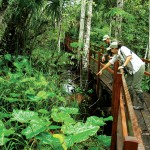More than 60% of the Peru’s territory is covered by the Amazon rainforest, making it the fourth country with the largest area of rainforest cover in the world. The Peruvian Amazonian forests are home to over 300,000 indigenous people who depend on it for their livelihood. The Peruvian Amazon provides invaluable natural resources, water, food and natural medicines; it is one of the most bio-diverse regions in the world; and it plays a crucial role stabilizing global climate.
In Peru the two most famous cities from which to visit the surrounding rainforest are Iquitos and Puerto Maldonado. Iquitos is located in the far north of Peru on the banks of the Amazon River. Puerto Maldonado is located in the South of Peru close to the border with Bolivia and Brazil.
Puerto Maldonado
Its location gained quite some importance when it comes to having great lodges and amazingly accessible rainforest. The city of Puerto Maldonado is a relatively small town located at the confluence of the Madre de Dios and Tambopata Rivers. The city is reached by road or by plane from Lima or Cusco. The road from Cusco takes about 10 hours by bus, the main reason why most people fly to Puerto Maldonado. These are some of the most pristine primary rain forests in the world, which include several oxbow lakes and clay licks, where hundreds of birds including macaws feed on clay.
Sandoval Lake
It is approximately 3 km / 2 miles long, in this habitat lives a great variety of birds, like cormorants, toucans, macaws, parrots, horned screamers, and herons. In addition, there is a colorful variety of wild hens called hoatzin or shansho, which heads are topped with feathers. With some luck, tapirs, turtles, and giant otters or “river wolves” can be seen as well as different species of crocodiles, like the black caiman.
Tambopata National Preserve
Located between the basins of the Tambopata and Heath Rivers, the reserve covers an area of 274.690 hectares and is found in both the Madre de Dios and Puno departments. The wealth of its biodiversity is immeasurable, and scientists have already registered 632 bird species, 1200 butterfly species, 169 mammal species, 205 fish species, 103 amphibian species, and 67 reptile species. The vegetation is typical of tropical regions. Here you can find the world’s largest Macaw lick, where hundreds of parrots and macaws of up to 15 species congregate daily to ingest the detoxifying clay, is located less than 500 meters from Tambopata Research Center.
Province of Manu
Manu National Park is spread out between two departments, Cusco and Madre de Dios, and covers an area of 1,692,137 hectares (or the entire Manu River basin). The park has a great variety of animal species: more than 800 bird, 200 mammal species and over a hundred bat species. In addition, there are trees over 45 meters high and 3 meters in diameter.
Iquitos
Is the largest city in the jungle with over 400,000 people. It is one of the most populated cities in the world that cannot be reached by road, the only options available are either by air or boat. The complex cultural life of Iquitos consists mainly of native iquiteños, Brazilians, Colombians, Chineses and settled expatriates ethnicities. The term “charapa culture” generally refers to social, cultural and artistic movements of Iquitos.





